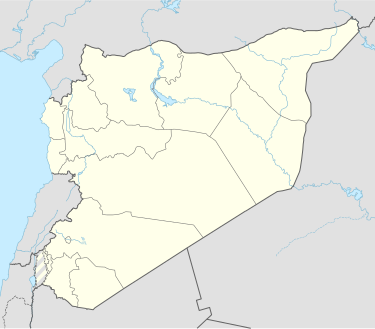Sumur (Levant)
 The location of Zimyra/Sumur (in the north) | |
| Alternative name | Sumura, Zemar, etc. |
|---|---|
| Location | Syria |
| Region | Tartus Governorate |
| Coordinates | !34°42′29″N 35°59′10″E / 34.7081°N 35.9861°E |

Sumur (Biblical Hebrew: צְמָרִי [collective noun denoting the city inhabitants]; Egyptian: Smr; Akkadian: Sumuru; Assyrian: Simirra) was a Phoenician city in what is now Syria. It was a major trade center. The city has also been referred to in English publications as Simyra,[1] Ṣimirra, Ṣumra,[2] Sumura,[3] Ṣimura,[4] Zemar,[5] and Zimyra.[6]
Sumur (or "Sumura") appears in the Amarna letters (mid-14th century BCE); Ahribta is named as its ruler. It was under the guardianship of Rib-Addi, king of Byblos, but was conquered by Abdi-Ashirta's expanding kingdom of Amurru. Pro-Egyptian factions may have seized the city again, but Abdi-Ashirta's son, Aziru, recaptured Sumur. Sumur became the capital of Amurru.[7]
It is likely, although not completely certain, that the "Sumur" of the Amarna letters is the same city later known as "Simirra."[8] Simirra was claimed as part of the Assyrian empire by Tiglath-Pileser III in 738 BCE, but rebelled against Assyria in 721 at the beginning of the reign of Sargon II.[9]
It has been linked by Maurice Dunand and N. Salisby to the archaeological site of Tell Kazel in 1957.[10]
References
[edit]- ^ Archibald Henry Sayce (1903). The Hittites: the story of a forgotten empire. The Religious Tract Society. p. 164.
- ^ Oded Lipschitz (2005). The Fall and Rise of Jerusalem: Judah Under Babylonian Rule. Eisenbrauns. p. 5. ISBN 978-1-57506-095-8.
- ^ Shlomo Izre'el; Itamar Singer; Ran Zadok (1998). Past Links: Studies in the Languages and Cultures of the Ancient Near East. Eisenbrauns. p. 393. ISBN 978-1-57506-035-4.
- ^ Niels Peter Lemche (1 March 1991). The Canaanites and Their Land: The Tradition of the Canaanites. A&C Black. p. 78. ISBN 978-1-85075-310-0.
- ^ Archibald Henry Sayce (1895). Patriarchal Palestine. Library of Alexandria. p. 24. ISBN 978-1-4655-5042-2.
- ^ I. E. S. Edwards; C. J. Gadd; N. G. L. Hammond; E. Sollberger (3 May 1973). The Cambridge Ancient History. Cambridge University Press. p. 863. ISBN 978-0-521-08230-3.
- ^ Trevor Bryce. The Kingdom of the Hittites. p. 182.
- ^ Trevor Bryce (10 September 2009). The Routledge Handbook of the Peoples and Places of Ancient Western Asia. Routledge. p. 672. ISBN 978-1-134-15907-9.
- ^ Trevor Bryce (10 September 2009). The Routledge Handbook of the Peoples and Places of Ancient Western Asia: The Near East from the Early Bronze Age to the fall of the Persian Empire. Routledge. p. 654. ISBN 978-1-134-15907-9.
- ^ Badre, Leila., Tell Kazel-Simyra: A Contribution to a Relative Chronological History in the Eastern Mediterranean during the Late Bronze Age, American University of Beirut, Lebanon, Bulletin of the American Schools of Oriental Research, 2006.
